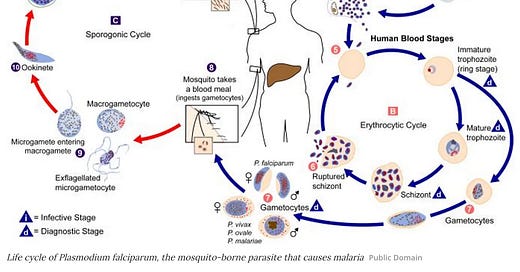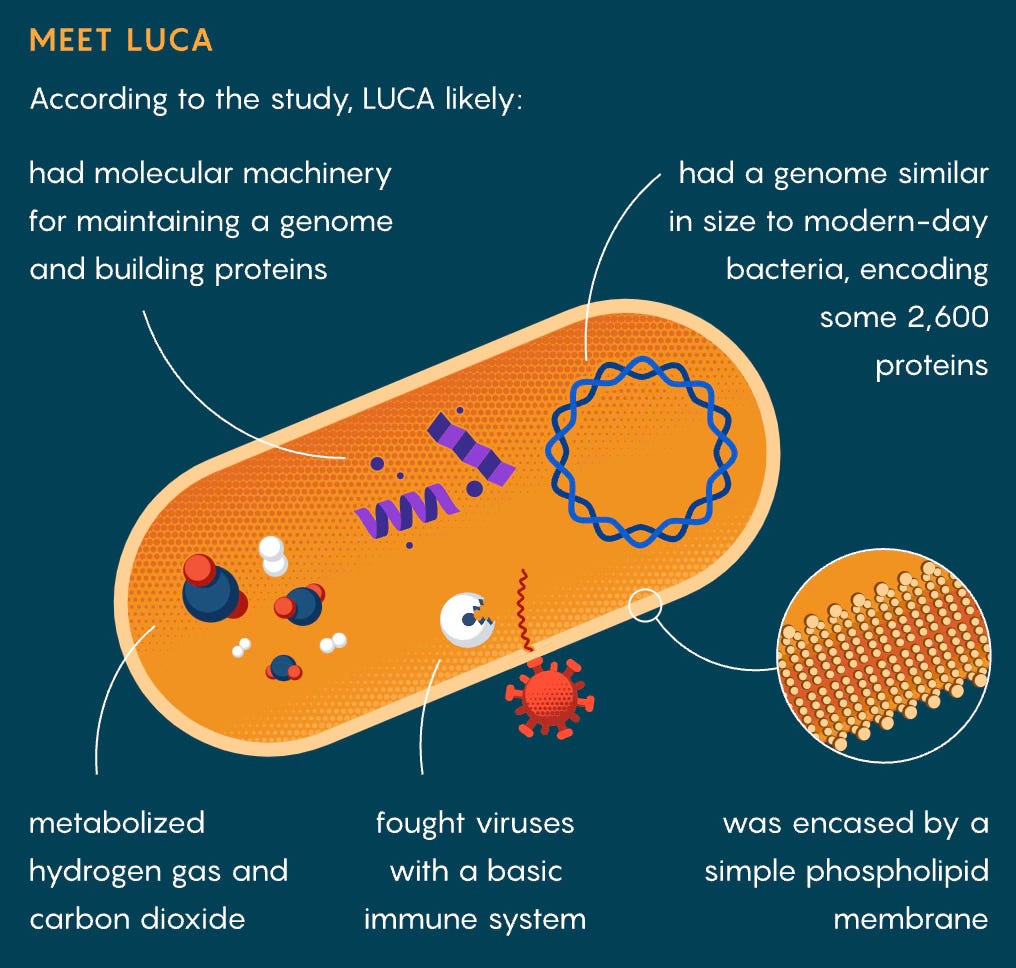Malaria Vaccine delivered by Mosquito bite, LUCA our Oldest Common Ancestor and a Strange Chemical in US Drinking Water
November 28
This week we examine a new way of delivering a Malaria vaccine to people in affected areas. We investigate LUCA, the single celled organism from which we all likely descended. We discover a strange chemical that is found in US drinking water and likely in drinking water in many countries in the world. Finally we look at a new method from removing those troublesome nanoplastics from our drinking water.
Delivering a Malaria Vaccine via a Mosquito Bite
Mosquitos are extremely efficient at spreading diseases like Malaria. To date we have tried to stop or kill the mosquitos without success. A new approach uses the mosquitoes to distribute a vaccine that will provide immunity.
Malaria is caused by the Plasmodium falciparum parasite, the deadliest parasite to humans. The parasite travels to the liver and infects red blood cells. 250 million people a year are infected around the world, with 608,000 deaths in 2022.
Each bite from a female mosquito injects up to 200 Plasmodium falciparum. They reproduce and within a week 100,000 new parasites are in your blood stream.
A team from the London School of Hygiene and Tropical Medicine decided to use the parasites strengths against it. They developed an approach where they let the parasite behave as normal up until it settles in the human liver cells and starts to multiply.
The team modified the parasites so that they stop developing after 6 days in the body. Secondary parasites are therefore not released into the blood stream. However this is enough time for a whole heap of antigens to be released into the blood stream which triggers a strong response from the human immune system. This response is then immediately triggered the next time an unmodified malaria carrying parasite arrives in a liver cell. This is how all vaccines are designed to work. When the body recognizes a previous infection an immune response is triggered.
Human testing was conducted where subjects were bitten by mosquitos carrying the modified parasite. The tests showed that subjects with exposure to the modified parasite (v a control group) had an 89% immunity from infection in subsequent exposures to the real parasite. Much larger trials will now take place to confirm the results in a larger and more diverse population sample.
The logistics and expense of vaccinating a whole population with regular boosters is still to be determined. Getting the modified parasites into mosquitos is quite labour intensive. The parasites are cultured in a lab on human blood cells and then feed to mosquitoes. It takes another two weeks for the mosquitos to be ready to go out and bite people. It is however an intriguing idea and a step forward in developing a solution to a very difficult problem.
Our Universal Common Ancestor
If we trace our ancestry back, I mean right back to our Last Universal Common Ancestor (or LUCA) we will find we and all life on earth, emerged from some ancient single celled organism. This organism may have been part of a population of single celled organisms however we will have emerged from one single organism.
LUCA is not the origin of life. It is not the first cell and it is not the first microbe. It is the moment when new forms of life took off. It is the most distant ancestor to all forms of life on the planet. Understanding LUCA may help us understand where we came from and help us understand the conditions required for life. It may help us find out if we are alone in the universe.
A broad multidisciplinary team at the University of Bristol have combined their knowledge to build a probabilistic model that reconstructs our shared ancestor and made estimates of when it lived. The team believed that LUCA lived off hydrogen gas and carbon dioxide, it has a genome as large as that of some modern bacteria and a rudimentary immune system. LUCA was likely one of many lineages (the rest of which are extinct) living about 4.2 billion years ago.
The oldest traces of life that we have found to date originate about 3.5 billion years ago. We can only study LUCA’s descendants. We can however backcast from there and develop models of what LUCA was actually like and when it lived. The team built an evolutionary tree of 350 living bacterial species and 350 Archean species (a domain of organisms). They then analyzed 10,000 gene families shared by those species to create an evolutionary tree for each gene.
There are many complications that could impact this analysis of the evolutionary tree for each gene. Including horizontal gene transfer (the movement of genes between organisms rather than from parent to offspring), genes dying out or evolving later in an evolutionary cycle among others. To overcome these complications the team computed the probability that a particular gene was present by comparing species trees and estimating the rates of horizontal gene transfer, gene loss and other evolutionary processes.
The team identified 399 gene families with a high chance of being part of LUCA and they estimate that LUCA’s genome encoded roughly 2,600 proteins.
The estimate that LUCA lived 4.2 billion years ago, about 300 millions years after the formation of the moon. The moon is thought to have been formed via a collision with a Mars sized planet. It would have taken 100 to 200 millions years for the earth to settle down enough to support life.
Building out this picture of LUCA via a more detailed study of everything alive today is a vastly bigger task. Even if we achieved this, it would only tell us about LUCA’s first steps. The chemists would have to fill in the gaps about how life emerged.
Strange Chemical in US Drinking Water
This is not one of those newly popular conspiracy theories but the result of a 40 year research project to find out what happens when we use Chloramines to decontaminate water. Chloramines are derived from combining Chlorine and Ammonia and have been used to effectively decontaminate drinking water in many countries around the world for half a century.
It has taken the past 4 decades to identify the mysterious chemical. Researchers knew it was a byproduct of chloromine. It turns out to be a previously unknown chemical that the team has called chloronitramide anion. The compound is a combination of one chlorine atom, two nitrogen atoms and two oxygen atoms. We do not know if this compound is harmful to humans (we have been drinking it since the 1890’s) and further research is required to determine its affects.
Contaminants are unavoidable in our drinking water. The goal of decontamination is to reduce the contamination to a negligible and thus harmless level. The advantage of using chloramines to decontaminate water is that it removes substances that we know to be harmful. As one researcher in the field commented, “we probably should be more worried about all the microplastics that we know are in our water”.
Removing Microplastics from Water
Whilst we are on the topic, a team in Brazil at the University of Sao Paulo have developed a novel nano technology that can remove micro and nano plastics from water. Nanoplastics are able to pass through our biological defenses and as we have previously discussed, are present in all our organs including our brains.
The researchers used magnetic nanoparticles functionalized with polydopamine, a neurotransmitter present in humans. These nanoparticles can bind to micro and nanoplastic waste. The combined particles can be removed from water via application of a magnetic field.
Polydopamine mimics the adhesive properties of mussels in the way they cling to many surfaces. This enables them to adhere to the tiny fragments of plastic and allow their removal from water. The process has already proven useful in water treatment systems.
Paying it Forward
If you have a start-up or know of a start-up that has a product ready for market please let me know. I would be happy to have a look and feature the startup in this newsletter. Also if any startups need introductions please get in touch and I will help where I can.
If you have any questions or comments please comment below.
I would also appreciate it if you could forward this newsletter to anyone that you think might be interested.
Till next week.




